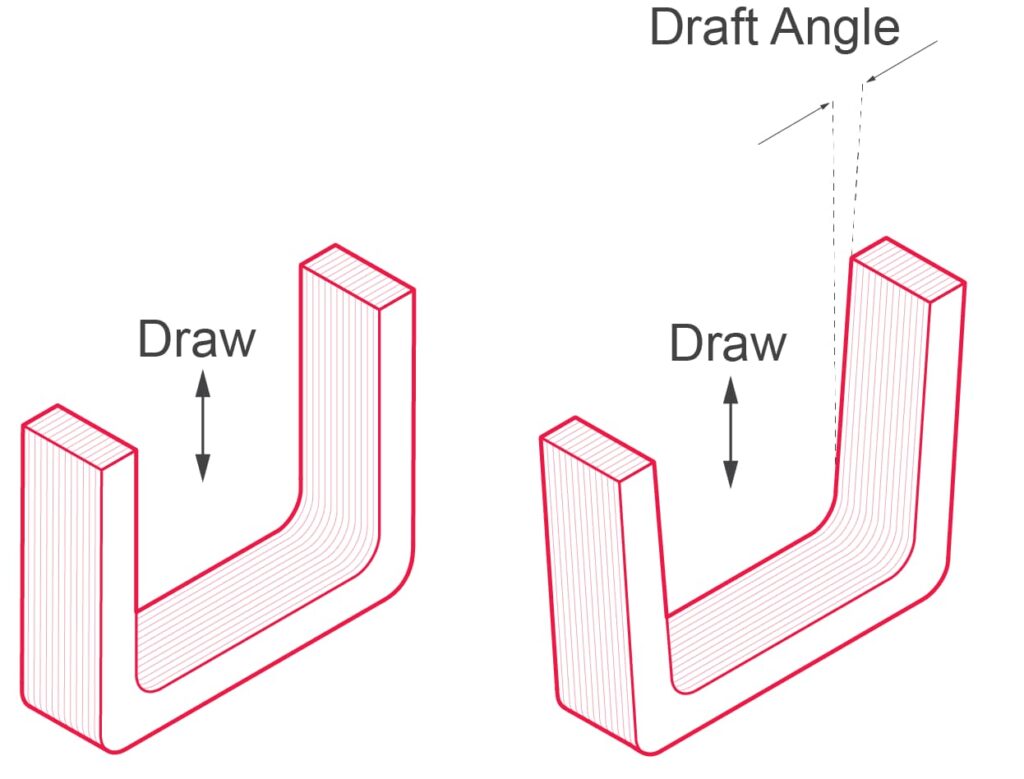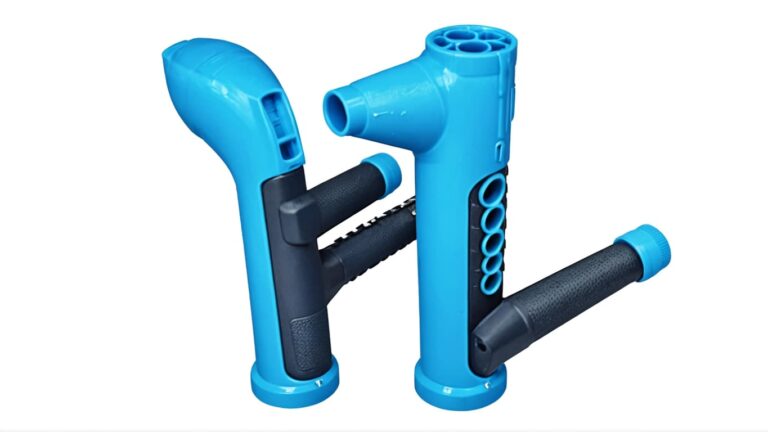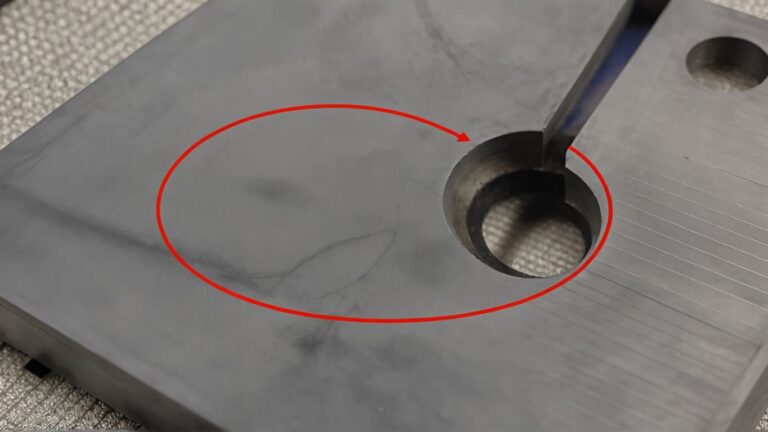A draft angle in injection molding refers to the slight taper applied to the vertical walls of a molded part. This taper allows for easier ejection from the mold, reducing the risk of defects or damage. Without a proper draft angle, parts may stick to the mold, causing deformation or requiring excessive force for removal.
Draft angles play a crucial role in mold design. They ensure smooth demolding, reduce wear on the tooling, and enhance the overall efficiency of the manufacturing process. Standard draft angles typically range from 1 to 3 degrees, though this can vary depending on material properties and surface finishes.
The application of draft angles significantly affects part ejection and manufacturing efficiency. Proper draft design minimizes cycle times by reducing the force needed to eject parts, which in turn lowers production costs. It also helps maintain part integrity, preventing warping or surface imperfections that could arise from improper ejection.
Incorporating draft angles into part design is essential for successful injection molding. A well-planned draft angle facilitates smooth mold release, reduces stress on both the part and the mold, and extends the lifespan of the tooling. Designers must consider draft angles early in the development process to avoid costly modifications later.
Draft angles enhance manufacturability by reducing friction during part ejection, which helps prevent defects such as drag marks or surface scratches. Additionally, they minimize the chances of parts getting stuck in the mold, which could lead to production delays and increased maintenance costs.
Inadequate draft angles can cause significant production issues. Without sufficient taper, parts may require excessive force for ejection, leading to deformation or mold damage. In extreme cases, improper draft design can result in mold failure, leading to expensive repairs and downtime.
While most injection-molded parts require a draft angle, there are scenarios where zero draft angles may be necessary. Achieving this is challenging and often requires specialized techniques such as advanced mold coatings, high-precision machining, or the use of flexible mold materials.
Zero draft angles impact both design and manufacturing. Parts with no draft require more complex mold designs, often incorporating additional features such as ejector pins or collapsible cores to facilitate removal. This can increase tooling costs and extend production time.
To achieve minimal or zero draft angles, designers must consider factors such as material shrinkage, surface finish requirements, and mold release agents. Alternative molding techniques, such as liquid silicone rubber (LSR) molding or 3D printing, can sometimes provide solutions for parts that require zero draft while maintaining manufacturability.
Draft angles are essential in manufacturing processes such as injection molding, die casting, and forging. Proper draft angles ensure smooth part ejection and reduce defects.
- Standard Draft Angle Recommendations: Most plastics require a draft angle of 1 to 3 degrees, while metals may need larger angles, often 3 to 5 degrees, due to their higher rigidity and tendency to stick to molds. For deep cavities or textured surfaces, draft angles may go up to 7 degrees.
- Factors Influencing Draft Angle Selection: Material properties, part complexity, mold type, and surface finish impact the required draft angle. For example, softer materials like polypropylene may require minimal draft, while rigid materials like polycarbonate need a steeper angle.
- Best Practices for Determining Draft Angles: Designers should consult manufacturing guidelines early in the design phase, use simulation software to predict ejection forces, and collaborate with mold engineers to optimize manufacturability.
Integrating the right draft angle in a design minimizes production costs and defects.
- Steps for Effective Draft Angle Integration: Start with a feasibility analysis, select the appropriate draft angle based on manufacturing constraints, and test using prototypes or simulations before finalizing the design.
- Considerations for Varying Draft Angles: Thin-walled parts typically require greater draft angles to prevent warping. Features like ribs or deep recesses may need different draft angles to ensure even material flow and prevent air entrapment.
- Common Mistakes to Avoid: Insufficient draft angles cause ejection issues and increase wear on molds. Designers should avoid inconsistent draft angles across a part, which can lead to unwanted stress concentrations and defects.
Draft angles can be classified as positive or negative, each serving specific purposes in manufacturing.
- Differences Between Positive and Negative Draft Angles: A positive draft angle widens outward from the mold base, allowing easier ejection. A negative draft angle tapers inward, which can make part removal more difficult unless specific mechanisms are used.
- Practical Applications: Positive draft angles are common in injection molding and casting, promoting smooth release. Negative draft angles are used in applications requiring interlocking features, such as snap-fit components.
- Manufacturing Impact: Positive draft angles improve production efficiency and mold longevity. Negative draft angles, while sometimes necessary, increase manufacturing complexity and tool wear, requiring careful design considerations.
By following these guidelines, designers can optimize part manufacturability, improve product quality, and reduce production costs.
Draft angles play a crucial role in simplifying the removal of parts from molds. Without a proper draft, parts may adhere to the mold walls, leading to increased ejection force requirements and potential damage. According to industry standards, a typical draft angle ranges between 1 to 3 degrees, depending on the material and mold design.
The quality of a part’s surface finish is also influenced by the draft angle. A well-designed draft reduces friction between the part and the mold, minimizing defects such as drag marks or surface irregularities. For example, thermoplastic injection molding benefits significantly from appropriate draft angles, as smoother ejection results in fewer post-processing requirements.
In manufacturing, draft angle decisions impact a variety of scenarios, including plastic injection molding, die casting, and thermoforming. For instance, in automotive component production, improper draft angles can lead to increased cycle times due to part sticking, ultimately reducing efficiency. By carefully considering draft angles, manufacturers can optimize both production speed and quality.
Incorporating draft angles into the design phase directly affects manufacturing costs. Proper draft reduces the chances of defects and minimizes the need for secondary finishing processes, leading to lower labor and material costs. According to a study by the American Society of Mechanical Engineers (ASME), optimizing draft angles can reduce production costs by up to 15% due to improved mold longevity and reduced rejection rates.
The cost benefits of using appropriate draft angles include fewer production delays and lower maintenance expenses for molds. Since draft angles prevent excessive wear on mold surfaces, they extend the lifespan of tooling, reducing replacement costs. Additionally, manufacturers can achieve faster cycle times, which translates to increased throughput and revenue.
Long-term savings come from reduced defects and improved production efficiency. A well-designed draft angle decreases the likelihood of part deformation or breakage, which in turn lowers waste and rework costs. Over time, businesses that implement proper draft angles experience fewer disruptions in their supply chains, leading to more consistent product delivery and customer satisfaction.
Neglecting draft angles in mold design introduces several problems. One major issue is part sticking, which can lead to increased ejection force requirements and potential damage to both the part and the mold. This can cause production delays and higher defect rates, ultimately increasing manufacturing costs.
Inadequate draft angles can also result in mold damage. When parts are forcibly removed from molds, they may cause excessive wear or even cracking of the mold surfaces. This not only shortens the mold’s lifespan but also leads to costly repairs or replacements. For example, in aluminum die casting, insufficient draft angles can cause metal buildup in the mold, leading to defects and downtime for cleaning.
To mitigate these risks, manufacturers should follow best practices such as conducting mold flow analysis and using computer-aided design (CAD) simulations to determine optimal draft angles. Educating design teams about the importance of draft angles and incorporating them early in the design phase can prevent expensive mistakes and enhance overall production efficiency.
Draft angles are essential in manufacturing processes like injection molding, casting, and thermoforming because they ensure easy part ejection and reduce defects. Designers should incorporate draft angles when working with molds or dies where material shrinkage can cause sticking. Industries such as automotive, consumer electronics, and medical devices rely on draft angles to improve production efficiency and product durability. Early consideration of draft angles prevents costly modifications later in the design process, reducing lead times and manufacturing expenses.
Integrating draft angles in prototypes helps designers verify manufacturability before mass production. By incorporating draft angles in 3D-printed or machined prototypes, engineers can assess how parts will behave in real-world conditions. Ignoring draft angles in early prototypes can lead to unrealistic expectations and design flaws during production. Testing draft angles involves measuring part fit, evaluating surface finishes, and ensuring ease of assembly. Using digital simulations alongside physical prototypes enhances validation accuracy.
Different materials require varying draft angles due to differences in shrinkage rates, friction, and rigidity. For example, thermoplastics like ABS and polycarbonate typically need 1-3° draft angles, while softer materials such as rubber may require higher angles to prevent tearing. Material properties like elasticity and surface texture influence draft angle selection, as rougher surfaces need more clearance for smooth ejection. Choosing the right material early in the design process ensures better mold performance and minimizes defects like warping or sink marks.
Design for Manufacturability (DFM) analysis is a systematic approach to optimizing product designs for efficient manufacturing processes. It aims to identify potential production challenges early in the design phase, reducing costs and improving product quality. By focusing on manufacturability, engineers can minimize material waste, enhance production speed, and prevent common manufacturing defects.
DFM analysis plays a crucial role in refining draft angle design, particularly in processes like injection molding. Proper draft angles ensure that parts can be easily ejected from molds without defects such as warping or surface damage. Without adequate draft, manufacturers may face increased production costs due to higher rejection rates and tool wear.
An effective DFM analysis includes several key components:
- Material Considerations: Selecting the right materials based on mechanical properties and manufacturability.
- Geometric Optimization: Ensuring features like draft angles, fillets, and wall thicknesses are optimized.
- Tooling and Process Compatibility: Verifying that the design aligns with manufacturing capabilities and tooling constraints.
- Cost and Efficiency Analysis: Identifying design choices that can reduce cycle times and minimize waste.
Improving draft angles through DFM analysis involves systematic evaluation and optimization to enhance moldability. Several strategies can be employed:
- Early Design Assessment: Integrating DFM analysis from the initial design phase helps avoid costly modifications later.
- Standardized Guidelines: Following industry best practices for draft angles (typically 1 to 3 degrees for most plastics) ensures manufacturability.
- Simulation and Prototyping: Using digital simulations and prototypes to assess the impact of different draft angles on mold release.
A structured approach to draft angle optimization offers multiple benefits:
- Reduced Manufacturing Defects: Proper drafts prevent issues like drag marks and surface imperfections.
- Lower Production Costs: Well-designed drafts reduce tool wear and maintenance requirements.
- Faster Production Cycles: Easier part ejection leads to more efficient manufacturing.
Real-world examples highlight DFM’s effectiveness in injection molding. For instance, companies in the automotive sector have successfully used DFM principles to refine draft angles, leading to improved fit, finish, and durability of plastic components. Similarly, consumer electronics manufacturers apply DFM techniques to optimize enclosures, ensuring smooth assembly and consistent quality.
DFM analysis relies on various tools and techniques to evaluate and enhance draft angles. Some of the most widely used tools include:
- 3D CAD Software: Applications like SolidWorks, Siemens NX, and Autodesk Fusion 360 allow engineers to visualize and adjust draft angles.
- Finite Element Analysis (FEA): Helps assess stress distribution and potential deformation caused by inadequate drafts.
- Mold Flow Analysis: Software such as Moldflow and Moldex3D simulates the injection molding process to identify potential issues.
Leveraging these software tools provides several advantages:
- Accurate Draft Angle Evaluation: Engineers can assess manufacturability before production.
- Optimized Material Flow: Simulations reveal areas where drafts may need adjustments to prevent defects.
- Data-Driven Decision Making: Analytical insights help refine designs based on real-world manufacturing conditions.
Best practices for conducting a thorough DFM analysis include:
- Collaborating with Manufacturers: Engaging with tooling and production teams early in the design process ensures feasibility.
- Iterative Testing: Refining designs through multiple simulation and prototyping cycles improves outcomes.
- Standard Compliance: Adhering to DFM guidelines and industry standards ensures consistency and reliability across manufacturing processes.
By implementing these tools and techniques, engineers can enhance draft angle designs, streamline production, and reduce overall manufacturing costs.



